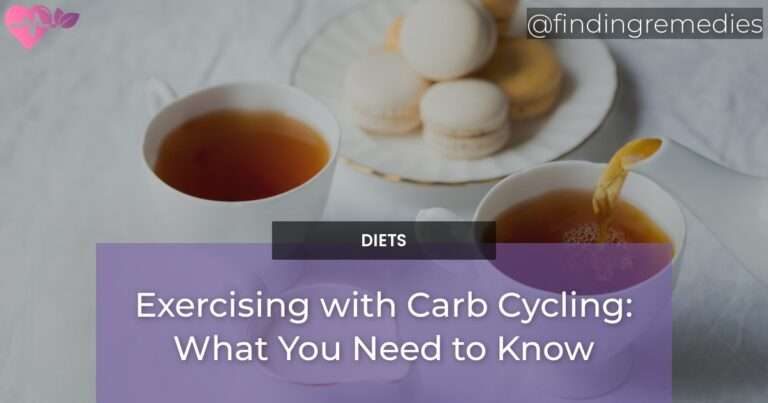When it comes to achieving fitness goals, diet and exercise go hand in hand. One popular diet strategy that has gained traction in recent years is carb cycling. This approach involves alternating between high and low carbohydrate intake throughout the week, with the goal of maximizing fat loss and muscle gain. But what about combining carb cycling and exercise?
In this article, we will explore the benefits of combining carb cycling and exercise and provide you with all the information you need to know to get started.
Table of Contents
Benefits of combining carb cycling and exercise
Combining carb cycling with exercise can offer a range of benefits that can help you reach your fitness goals faster. One of the main advantages is improved fat loss and muscle gain. By strategically timing your carbohydrate intake, you can optimize your body’s ability to burn fat and build lean muscle mass.
Another benefit of exercising with carb cycling is enhanced energy levels and stamina. By consuming carbohydrates at the right times, you can ensure that your body has enough fuel to power through your workouts and perform at its best.
Additionally, carb cycling can help with optimal nutrient utilization and recovery. By cycling your carbohydrate intake, you can ensure that your body is efficiently using the nutrients from your diet to support muscle repair and recovery after exercise.
Timing carb intake around workouts
Consuming carbs before exercise
One strategy for maximizing the benefits of carb cycling and exercise is to consume carbohydrates before your workouts. This can help provide the energy needed to fuel your performance and improve your overall workout quality. Aim to consume a combination of complex carbohydrates and a small amount of protein about 1-2 hours before your workout.
Utilizing carbs during exercise
In some cases, especially during longer and more intense workouts, it may be beneficial to fuel your body with carbohydrates during exercise. This can help maintain energy levels and prevent fatigue. Consider consuming easily digestible carbohydrates, such as sports drinks or gels, during prolonged exercise sessions.
ALSO READ
Replenishing carbs post-workout
After completing your workout, it’s important to replenish your carbohydrate stores to support recovery and muscle glycogen replenishment. Aim to consume a combination of carbohydrates and protein within 30-60 minutes post-exercise to optimize recovery.
Fueling high-intensity exercise
When it comes to high-intensity workouts, carbohydrates play a crucial role in providing the energy needed to perform at your best. It’s important to choose the right type of carbs to fuel your workouts effectively.
Complex carbohydrates, such as whole grains, fruits, and vegetables, are ideal choices as they provide a steady release of energy. Avoid simple sugars and processed carbs, as they can lead to energy crashes and hinder performance.
Preventing fatigue and crashes
Balancing carbohydrate intake to avoid energy crashes
While carb cycling can be an effective strategy, it’s essential to find the right balance of carbohydrates to prevent energy crashes. Consuming too few carbs on low carb days can lead to fatigue and decreased exercise performance. Conversely, consuming too many carbs on high carb days can hinder fat loss. Experiment with different carb intake levels to find what works best for you.
Incorporating rest days and recovery periods
Rest days and recovery periods are just as important as exercise itself. Make sure to include rest days in your carb cycling workout plan to give your body time to repair and rebuild. During these periods, you may opt for lower carbohydrate intake to support recovery.
Sample carb cycling workout plans
High carb day workout plan
On high carb days, you can fuel your workouts with a higher intake of carbohydrates. This can include foods such as whole grains, fruits, and starchy vegetables. Aim to consume the majority of your carbohydrates before and after your workouts to optimize performance and recovery.
Low carb day workout plan
On low carb days, you may opt for a lower intake of carbohydrates. Focus on consuming lean proteins, healthy fats, and non-starchy vegetables. While your energy levels may be slightly lower on these days, your body will still be able to perform well with the available resources.
Strategies for transitioning between high and low carb days
Transitioning between high and low carb days can be challenging at first. To make the process smoother, consider gradually decreasing your carbohydrate intake over a few days leading up to your low carb days. Similarly, gradually increase your carbohydrate intake in the days leading up to your high carb days. This can help prevent any sudden drops or spikes in energy levels.
Lifting vs cardio on high/low carb days
Adjusting carb intake based on exercise type
Depending on your exercise routine, you may need to adjust your carb intake accordingly. For weightlifting or resistance training workouts, you may benefit from a slightly higher carbohydrate intake on both high and low carb days to support muscle growth and recovery.
On the other hand, for cardio-based workouts, such as running or cycling, you may need to focus more on consuming carbohydrates on high carb days to provide the necessary energy for endurance activities.
Maximizing performance and results with appropriate carb consumption
Ultimately, the key to maximizing your performance and results with carb cycling and exercise is finding the right balance. Pay attention to your body’s individual needs and adjust your carbohydrate intake accordingly. Experiment with different strategies and listen to how your body responds to find what works best for you.
Conclusion
Exercising with carb cycling can be a powerful tool for achieving your fitness goals. By combining the benefits of carb cycling with strategic carbohydrate timing around your workouts, you can optimize fat loss, muscle gain, energy levels, and recovery. Remember to find the right balance of carbohydrates for your individual needs, and don’t forget to incorporate rest days and recovery periods. With careful planning and experimentation, you can harness the power of carb cycling to take your workouts and results to the next level.

